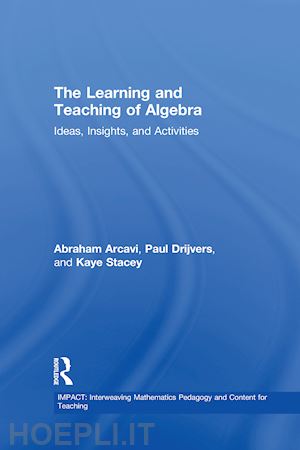
-
DISPONIBILITÀ IMMEDIATA
{{/disponibilitaBox}}
-
{{speseGratisLibroBox}}
{{/noEbook}}
{{^noEbook}}
-
Libro
-
-
SPEDIZIONE GRATUITA
The Learning and Teaching of Algebra
arcavi abraham; drijvers paul; stacey kaye
162,98 €
154,83 €
{{{disponibilita}}}
Disponibilità Normalmente disponibile in 20 giorni
NOTE EDITORE
IMPACT (Interweaving Mathematics Pedagogy and Content for Teaching) is an exciting new series of texts for teacher education which aims to advance the learning and teaching of mathematics by integrating mathematics content with the broader research and theoretical base of mathematics education. The Learning and Teaching of Algebra provides a pedagogical framework for the teaching and learning of algebra grounded in theory and research. Areas covered include: • Algebra: Setting the Scene • Some Lessons From History • Seeing Algebra Through the Eyes of a Learner • Emphases in Algebra Teaching • Algebra Education in the Digital Era This guide will be essential reading for trainee and qualified teachers of mathematics, graduate students, curriculum developers, researchersand all those who are interested in the "problématique" of teaching and learning algebra. It allows you to get involved in the wealth of knowledge that teachers can draw upon to assist learners, helping you gain the insights that mastering algebra provides.SOMMARIO
Preface 1. Algebra – Setting the scene 1.1 Introduction 1.2 Algebra – Aims, actions and entities 1.2.1 Aims 1.2.2 Actions 1.2.3 Entities 1.3 Why Algebra? 1.4 Chapter Summary 1.5 Thinking further 1.6 References 2.Some lessons from history 2.1 Introduction 2.2 Linear equations in ancient Egypt 2.3 Quadratic equations in ancient Babylonia 2.4 A geometric view of algebra from Arabic mathematics 2.5 Beyond solving equations: The emergence of algebra in Europe 2.5.1 Some algebraic rules and their explanation 2.5.2 Negative numbers 2.6 Chapter summary 2.7 Thinking further 2.8 References 3. Seeing algebra through the eyes of a learner 3.1 Introduction – putting on teachers’ bifocal spectacles 3.2 What do algebraic letters represent? 3.2.1 Fruit salad algebra – misleading teaching with long term consequences 3.3 The process-object duality 3.4 The meaning of the equals sign 3.5 Algebra for recording and revealing mathematical structure 3.6 Transitions from arithmetic to algebra 3.6.1 Contrasting arithmetic and algebraic problem solving 3.6.2 Fundamental ideas of equation solving 3.6.3 Algebra and creativity 3.7 The procedures of equation solving 3.7.1 Process-object distinction in solving simultaneous equations 3.8 Functions as processes and objects 3.9 Chapter Summary 3.10 Thinking Further 3.11 References Chapter 4: Emphases in algebra teaching 4.1 Introduction 4.2 Teaching algebra in context 4.3 Productive practice 4.4 The reconciliation of routine and insight 4.5 Exploiting student mistakes 4.6 Proofs in algebra teaching 4.7 Chapter summary 4.8 Thinking further 4.9 References 5. Algebra education in the digital era 5.1 Introduction 5.2 Digital tools for algebra 5.2.1 Algebraic functionality of digital tools 5.2.2 Pedagogical roles of digital tools for algebra 5.3 Core algebra entities with digital means 5.3.1 Variable 5.3.2 Equation and equivalence 5.3.3 Function 5.4 Teaching and learning algebra with digital means 5.5 Chapter summary 5.6 Thinking further 5.7 References EpilogueAUTORE
Abraham Arcavi holds the Lester B. Pearson Professorial Chair at the Weizmann Institute of Science, Israel. He has written about the teaching and learning of algebra for researchers and teachers, led large curriculum development projects, and has been involved in teacher professional development for more than 30 years. Paul Drijvers is Professor of Mathematics Education at the Freudenthal Institute, Utrecht University, The Netherlands. His research interests include the role of ICT in mathematics education, the teaching and learning of algebra, and teachers’ professional development. Kaye Stacey is Professor Emeritus at the University of Melbourne, Australia, having held the Foundation Chair of Mathematics Education there for 20 years. She has made major contributions to understanding students’ early learning of formal algebra and discovering how information technology can enhance the teaching of algebra and functions throughout secondary school.ALTRE INFORMAZIONI
- Condizione: Nuovo
- ISBN: 9780415743693
- Collana: IMPACT: Interweaving Mathematics Pedagogy and Content for Teaching
- Dimensioni: 9.25 x 6.25 in Ø 0.99 lb
- Formato: Copertina rigida
- Illustration Notes: 12 tables, 27 halftones and 19 line drawings
- Pagine Arabe: 144
- Pagine Romane: xiv
